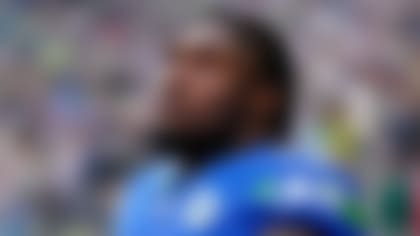They are two seasons removed from a Super Bowl appearance and riding the NFC's longest streak of division titles, with four in a row. Yet the Seattle Seahawks figure as the so-called X-factor in the conference playoffs, because no one knows what to expect from them.
Why is that? Well, in large measure, it's because the Seahawks have re-made themselves just two years after reaching the Super Bowl -- with Mike Holmgren, in his 16th season as an NFL head coach, going back on two of the coaching tenets he grew up with, and with a good defense, something virtually unknown in the Pacific Northwest.
You know that so-called Super Bowl-loser jinx, the one in which the team that loses the final game has a losing season the next year? Apparently, it lasts for more than a year. Of the last six teams that reached the Super Bowl and lost, only Seattle will finish this season with a winning record.
In other words, the Seahawks have developed staying power that many others that came close to the mountaintop could not.
Here's a look at how Seattle, which is 10-5 and locked into the NFC's third seed in the playoffs, did it this time:
1. The shotgun
When Holmgren worked for Bill Walsh as the San Francisco 49ers' quarterbacks coach in the '80s, the shotgun formation was a four-letter word. Walsh, concerned the shotgun would change the intricate timing his offense required, finally relented one offseason and told Holmgren to work on some shotgun plays.
That experiment, as it turned out, lasted as long as it took for center Fred Quillan to snap a ball over Joe Montana's head in a preseason game. Walsh told Holmgren to forget the shotgun, and he pretty much did -- until this year, when the Seahawks are using it frequently on third-down plays, and it's helping.
Holmgren says Walsh, who died last summer, is "probably up there, just kind of shaking his head at me right now."
Quarterback Matt Hasselbeck likes the shotgun, and while it is not a staple of the Seattle offense (used just three times in Sunday's victory over Baltimore), Holmgren has managed to incorporate it and not lose the precise timing. In fact, Holmgren's offense remains, a decade and a half after he left San Francisco, the closest to what the 49ers used to do.
2. The passing game
When Holmgren left the 49ers to become the Green Bay coach for the 1992 season, Packers general manager Ron Wolf said one of his attractions to Holmgren was Holmgren's belief in a strong running game. Because the 49ers had Hall of Fame quarterbacks, the running game didn't get as much notice during their successful run, but it was usually good.
This year, however, when Seattle found itself, after an ugly, 33-30 overtime loss at Cleveland, with a 4-4 record at midseason and an ineffective running game ranked near the bottom of the league, Holmgren basically ripped the run game out of the playbook and turned the offense over to Hasselbeck's arm.
Since then, Seattle has won six of seven games.
With one game remaining, Hasselbeck already has set a Seahawks' franchise record for passes attempted and completed in a season, is just 22 yards short of the team record for yardage, and has the second-best passer rating of his career.
"We're having fewer bad plays now," Holmgren said. "In the beginning of the season, when we were attempting to run the ball a little bit more, we had a lot of bad plays, one-yard gains, and then we got in too many third-down situations. It was just too hard. Everything was too hard.
"Then we got to the halfway point at 4-4, [running back] Shaun [Alexander] got hurt, then we got our two receivers [D.J. Hackett and Deion Branch] back [from the injury list], and it all coincided.
"Bill [Walsh] used to always say, a lot of good ideas are on the table, but sometimes it doesn't work. So just back away and try something else."
The something else was the passing game that Holmgren always knew better than the run game, anyway. And even though Hackett is missing time again with his second ankle injury of the season, Branch, Bobby Engram and Nate Burleson all are healthy and helping to carry the offense in three-receiver sets.
Two years ago, the Seahawks won the NFC title and played in the Super Bowl with Alexander averaging more than five yards a carry and rushing for 27 touchdowns. This year, he is averaging 3.4 and has rushed for three touchdowns. And Maurice Morris, who took over when Alexander was out with an injury, is not only a much better receiver and pass blocker, but for a time he also was running better than Alexander.
"We're opening the formations more and trying to play to our strength right now, which is the quarterback, receivers and pass protection," Holmgren said. "We weren't run blocking very well. Matt's been playing well, and we're catching the ball, and success breeds success."
3. The defense
It's last on this list but more significant among the reasons the Seahawks managed to salvage their season. Historically, offense has overshadowed defense with the sexy West Coast offense teams, but even in San Francisco's heyday, the championship teams had strong defenses. Hardly anyone remembers this, but the launch of the 49ers' dynasty came not on Montana's arm but on a stunning defensive rise; the 1981 team, which won San Francisco's first title, ranked second in the NFL on defense but only 13th on offense and produced a game-saving goal-line stand in the Super Bowl.
For years, Seattle has been searching for a defense like that, but ever since Cortez Kennedy retired a decade ago, the Seahawks have floundered near the bottom of the league. No matter what the Seahawks tried -- whether trading with the Saints for Norman Hand, signing Grant Wistrom in free agency, drafting defensive players with their first two picks two years in a row -- they couldn't advance very far.
But that has changed since 2005, when Holmgren gave up the general manager's duties and Tim Ruskell arrived from Atlanta as the team's president and GM. Earlier in Holmgren's term, the Seahawks had put most of their money in acquiring the offensive players needed to run his system, but over the last three years they did a splendid job of manning the defense.
Eight of the 11 defensive starters have arrived in that time, including safeties Deon Grant and Brian Russell, signed as free agents for the 2007 season, along with defensive end Patrick Kerney, who leads the NFL with 14.5 sacks.
Jim Mora Jr., who also joined the team this year as assistant head coach and defensive backfield coach, has helped infuse more enthusiasm into the John Marshall-coordinated defense, too. Mora orchestrated one of the team's key moves, shifting Marcus Trufant, Seattle's best cornerback, from the right side to the left. The Seahawks had been playing him on the right to protect an old shoulder injury, but on the left side, he's more often covering the opponent's best receiver and has more impact.
"He should receive a lot of credit for our improvement in the secondary," Holmgren said of Mora. "I think he has a really good way of communicating with the players. He's tough on them, but he's not a big yeller at practice. He gets close to them, and as far as I can tell, they listen to him.
"Bill's old adage was if you 'bust' a guy, make sure you pat him on the back before they leave the field, and Jim does that well."
Trufant, who is tied for second in the NFL with seven interceptions, Kerney, outside linebacker Julian Peterson and middle linebacker Lofa Tatupu all were selected for the Pro Bowl, matching Seattle's total of defensive Pro Bowl selections for the last six years. Seattle has allowed only eight more points than New England and Tampa Bay, which have allowed the fewest in the league.
The bottom line
Seattle will open the playoffs at home against Washington, Minnesota or New Orleans and, if it wins that game, Holmgren will take the Seahawks to Green Bay, where he began his head-coaching career. It's a long climb from the Wild Card Round to the Super Bowl, something only one NFC team (Carolina in 2003) ever accomplished, and it's particularly long for the Seahawks, who have a dismal record on the road through the years.
But the second-half rally clearly has energized Holmgren, who will turn 60 before the 2008 season. While it's still questionable whether he will want to coach beyond this year, he looks a lot better than he did during the early-season struggles.
"I think what happened was, we were inconsistent, to say the least," Holmgren said. "I thought we had a pretty good team. I was working very hard to try to figure the thing out ... and it wasn't happening. I think it wore me out a little bit early (in the season). I was frustrated. But if you keep working at it, sometimes stuff pops, and I think that's what happened."
Veteran NFL writer Ira Miller is a regular contributor to NFL.com.



